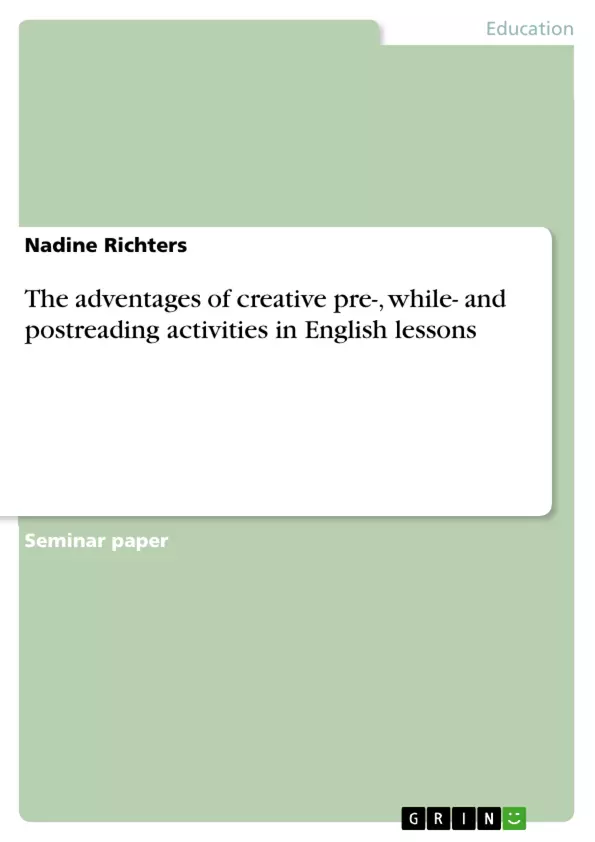Creative approaches to textual work play an important role in EFL1 lessons as they offer
a great potential with regard to developing language skills and intercultural learning and
as they are very popular among pupils. In terms of the negative results of PISA, the
approach to reading comprehension has immensely changed. Didactics have found out
that tackling (literary) texts in the traditional way hardly motivates learnes to achieve
good results. Therefore, it is more useful to centre topics and literary texts which have
significance for the learners, treat them in a different way and employing new methods,
such as reading different texts in the English lessons (for example „Harry Potter“) and
applying creative writing. Reading, writing, learning English should make sense to the
pupils. „ESL2/EFL learners need a reason to read.“3 Fortunately, these changes are
even visible in the current curricula guidelines.
In my term paper, I will lay the focus on pre-, while- and post-reading-activities with
regard to literature. Firstly, I will present the aims and advantages of while- and postreading-
activities, then I will carry out a practical approach by suggesting a short story
("Peter's Beach") and presenting some post-reading-activities and discussing them.
[...]
Inhaltsverzeichnis (Table of Contents)
- Introduction
- Creative methods in the lessons
- Aims and advantages
- Pre-reading-activities in detail
- While-reading-activities in detail
- A practical approach to a post-reading activity for "Peter's Beach"
- Summary
Zielsetzung und Themenschwerpunkte (Objectives and Key Themes)
This term paper aims to explore the benefits of using creative pre-, while- and post-reading activities in English lessons. The paper focuses on how these activities enhance language skills, intercultural learning, and pupil engagement, particularly in the context of literature.
- The importance of creative methods in EFL lessons for language acquisition and intercultural learning
- The challenges of traditional approaches to reading comprehension and the need for more engaging methods
- The benefits of creative pre-, while-, and post-reading activities in fostering reading comprehension and engagement
- The role of empathy, perspective-taking, and "Fremdverstehen" in intercultural learning through creative tasks
- The advantages of creative methods in addressing the specific needs of ESL/EFL learners
Zusammenfassung der Kapitel (Chapter Summaries)
The introduction outlines the significance of creative approaches in EFL lessons, particularly in light of the changing landscape of reading comprehension. The paper argues for a shift from traditional, analytical methods to more engaging, learner-centered approaches.
The chapter on "Creative methods in the lessons" delves into the aims and advantages of employing creative methods in EFL lessons, focusing on their ability to address key language skills, foster intercultural understanding, and enhance pupil engagement. The paper emphasizes the importance of addressing the specific needs of ESL/EFL learners and the limitations of traditional approaches.
Schlüsselwörter (Keywords)
This paper explores key terms such as creative methods, EFL lessons, reading comprehension, intercultural learning, "Fremdverstehen," empathy, and perspective-taking. The paper also emphasizes the importance of addressing the specific needs of ESL/EFL learners.
- Quote paper
- Nadine Richters (Author), 2009, The adventages of creative pre-, while- and postreading activities in English lessons, Munich, GRIN Verlag, https://www.grin.com/document/126866



